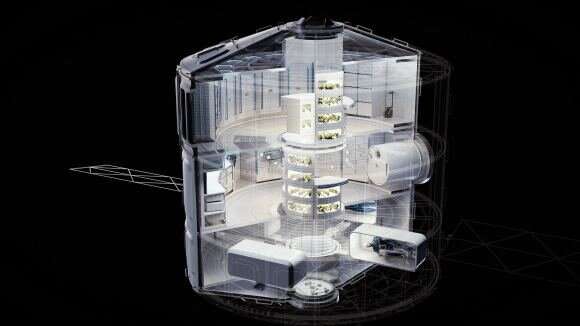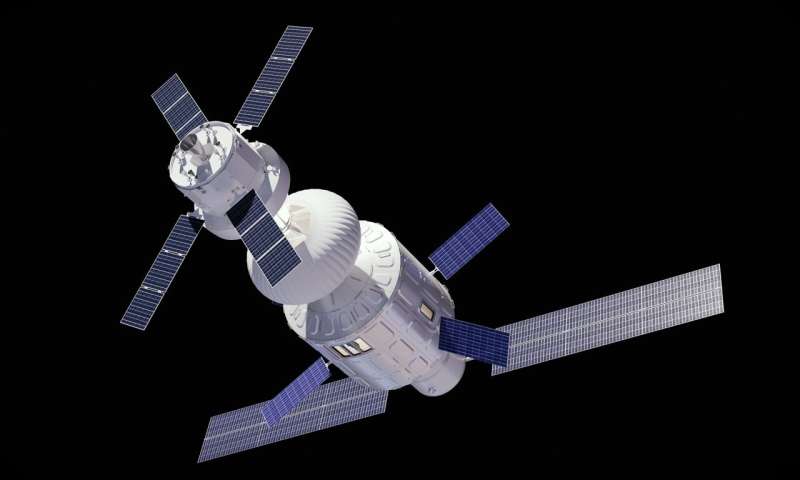As you can see from the video below, the interior design consists of three levels (or decks). These include (from top to bottom) a habitation deck, a science deck, and a centrifuge that simulates gravity for two crewmembers at a time. The module measures eight meters (about 26 feet) in diameter and roughly the same length, providing close to 100 cubic meters (~3500 ft3) of volume.
According to Airbus, separating the interior into different decks allows for an "internal safe harbor concept," meaning that the crew can move to the deck that affords the most protection in the event of a solar flare or other hazards.
Each deck is accessible via a central tunnel surrounded by a greenhouse structure that can accommodate plant experiments and provide a steady supply of supplemental greens, legumes, and other plants (similar to greenhouses aboard the ISS). The module is designed for a crew of four but can reportedly accommodate up to eight astronauts at a time (temporarily). The deck selection can be adapted to individual mission requirements and objectives, or the mechanical structure can be used alone (a "dry module").
Individual decks can be equipped with mission-specific machinery and infrastructure depending on the mission requirements. In the standard design, the Habitation Deck is essentially a "common area" with large windows and exercise equipment (stationary bikes).
The Science Deck is equipped with multiple computer terminals, an airlock that allows the crew to conduct extra-vehicular activities (EVAs), and smaller portholes to provide views of space. But what is perhaps the most interesting element of the LOOP is the centrifuge, which consists of two weights and two crew pods.
These pods contain exercise bikes and can accommodate a single crewperson, allowing the crew to work out (two at a time) in a simulated gravity environment. This three-deck design meets all of the basic needs of long-duration stays in space and (according to Airbus) makes the LOOP compatible with all crew and cargo vehicles, including those currently in service and those in development. This includes the ISS, where the LOOP would be integrated to provide additional volume and even "gravity therapy."

It could also be integrated into the Lunar Gateway or could act as the habitation module of the proposed Deep Space Transport (DST). Airbus also emphasizes that multiple LOOP modules can be combined to create a full-on space station, each outfitted with various decks to accommodate a range of operations and experiments. In this respect, the LOOP could occupy a role similar to what NASA had in mind with his proposed Non-Atmospheric Universal Transport Intended for Lengthy United States Exploration (Nautilus-X) concept.
There's no indication yet of how much gravity the Centrifuge will be able to simulate, but some brought calculations using SpinCalc and SpaceCalc provided some estimates. According to both apps, the Centrifuge would need to have an angular velocity of 3.86 m/s (12.66 ft/s) and achieve 9.2 rotations per minute to simulate Martian gravity—3.72 m/s2, or about 38% of Earth's. It is possible it could be spun down to 2.55 m/s (8.35 ft/s), making six rotations per minute, to simulate Lunar gravity (about 16.5%) as well.
This would be especially useful during missions to Mars since it would help mitigate the physiological effects of microgravity while acclimating the crew to what they will experience on the surface. Hopefully, more information will be available soon, including radiation shielding, materials, and weight estimates. Needless to say, NASA and other space agencies are facing some significant challenges when it comes to future missions and operations in space. These include renewed lunar exploration and development, the first crewed missions to Mars, and what to do once the ISS is decommissioned.
As always, NASA has called upon the commercial space sector to provide innovative solutions to these challenges, and they are answering.
Provided by Universe Today



